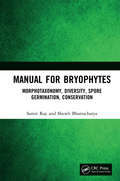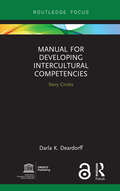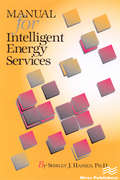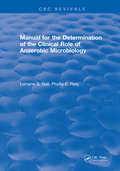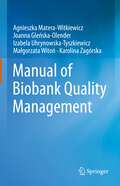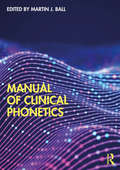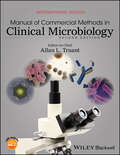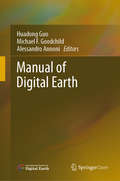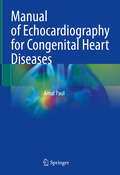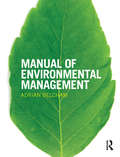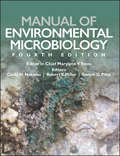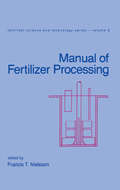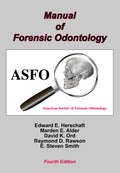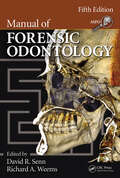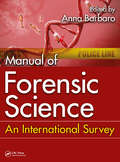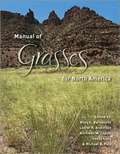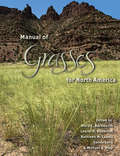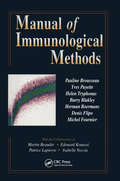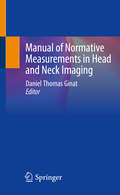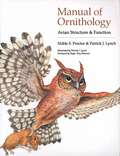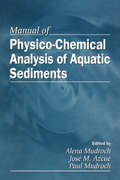- Table View
- List View
Manpower and Personnel Needs for a Transformed Naval Force
by National Research Council of the National AcademiesThe Department of Defense (DOD) is committed to transforming the nation's armed forces to meet the military challenges of the future. One approach to achieving this transformation is by leveraging advances in science and technology. New technologies and innovations are integral to today's military actions, and associated changes have rippled through all aspects of operations, highlighting the need for changes in policies related to military personnel. At the request of the Force Chief of Naval Operations, the NRC reviewed the military manpower and personnel policies and studies currently underway in the DOD and developed an implementation strategy for the Department of the Navy's future military manpower and personnel needs. This book presents an introduction to current personnel policies of and concerns facing the Naval forces; an assessment of demographic, technological, and other forces affecting future personnel needs and availability; a summary and assessment of previous studies; an examination of the role of research tools in implementing personnel policy change; and an analysis of obstacles to and strategies for transforming the Naval forces.
Mantle Convection for Geologists
by Geoffrey F. DaviesMantle convection is the fundamental agent driving many of the geological features observed at the Earth's surface, including plate tectonics and plume volcanism. Yet many Earth scientists have an incomplete understanding of the process. This book describes the physics and fluid dynamics of mantle convection, explaining what it is, how it works, and how to quantify it in simple terms. It assumes no specialist background: mechanisms are explained simply and the required basic physics is fully reviewed and explained with minimal mathematics. The distinctive forms that convection takes in the Earth's mantle are described within the context of tectonic plates and mantle plumes, and implications are explored for geochemistry and tectonic evolution. Common misconceptions and controversies are addressed - providing a straightforward but rigorous explanation of this key process for students and researchers across a variety of geoscience disciplines.
Manual for Bryophytes: Morphotaxonomy, Diversity, Spore Germination, Conservation
by Samit Ray Shewli BhattacharyaThis book will enrich the readers theoretical knowledge about the fundamental aspects of bryology. There is a great significance of bryophytes in land plant evolution, water retention, prevention of soil erosion, nutrient cycling, nitrogen fixation and pollution monitoring. Considering this, the authors found it necessary to provide a basic guideline to the students to study the bryoflora.The present manual for bryophytes will provide practical guidelines for collection and recording of bryophytes, methodologies for studying it's morphology, morphometry and internal structure, modern approach to bryophytes systematics and characterization of genera, taxonomic importance of spore ornamentation as revealed by the Scanning Electron Microscopy, significance of bryophyte conservation and basic methods of in vitro study. Please note: Taylor & Francis does not sell or distribute the Hardback in India, Pakistan, Nepal, Bhutan, Bangladesh and Sri Lanka.
Manual for Developing Intercultural Competencies: Story Circles (Routledge Focus on Environment and Sustainability)
by Darla K. DeardorffThis book presents a structured yet flexible methodology for developing intercultural competence in a variety of contexts, both formal and informal. Piloted around the world by UNESCO, this methodology has proven to be effective in a range of different contexts and focused on a variety of different issues. It, therefore can be considered an important resource for anyone concerned with effectively managing the growing cultural diversity within our societies to ensure inclusive and sustainable development. Intercultural competence refers to the skills, attitudes, and behaviours needed to improve interactions across difference, whether within a society (differences due to age, gender, religion, socio-economic status, political affiliation, ethnicity, and so on) or across borders. The book serves as a tool to develop those competences, presenting an innovative adaptation of what could be considered an ancient tradition of storytelling found in many cultures. Through engaging in the methodology, participants develop key elements of intercultural competence, including greater self-awareness, openness, respect, reflexivity, empathy, increased awareness of others, and in the end, greater cultural humility. This book will be of great interest to intercultural trainers, policy makers, development practitioners, educators, community organizers, civil society leaders, university lecturers and students – all who are interested in developing intercultural competence as a means to understand and appreciate difference, develop relationships with those across difference, engage in intercultural dialogue, and bridge societal divides.
Manual for Intelligent Energy Services
by Shirley J. HansenThis book is dedicated to the front line manager of America's economic life blood: energy. It is designed to help owners and managers first assess their organization's energy conditions, and then determine the best outsourcing strategies for needed services. The author shares experiences drawn from over 25 years in the energy business and work in over 30 countries, and provides succinct case studies to expand on important points raised and to provide insight into their application. The final section takes into account recent events which have highlighted the unpredictable situation surrounding our energy supplies, as well as how to make the most of it.
Manual for Survival: A Chernobyl Guide To The Future
by Kate BrownA chilling exposé of the international effort to minimize the health and environmental consequences of nuclear radiation in the wake of Chernobyl. Dear Comrades! Since the accident at the Chernobyl power plant, there has been a detailed analysis of the radioactivity of the food and territory of your population point. The results show that living and working in your village will cause no harm to adults or children. So began a pamphlet issued by the Ukrainian Ministry of Health—which, despite its optimistic beginnings, went on to warn its readers against consuming local milk, berries, or mushrooms, or going into the surrounding forest. This was only one of many misleading bureaucratic manuals that, with apparent good intentions, seriously underestimated the far-reaching consequences of the Chernobyl nuclear catastrophe. After 1991, international organizations from the Red Cross to Greenpeace sought to help the victims, yet found themselves stymied by post-Soviet political circumstances they did not understand. International diplomats and scientists allied to the nuclear industry evaded or denied the fact of a wide-scale public health disaster caused by radiation exposure. Efforts to spin the story about Chernobyl were largely successful; the official death toll ranges between thirty-one and fifty-four people. In reality, radiation exposure from the disaster caused between 35,000 and 150,000 deaths in Ukraine alone. No major international study tallied the damage, leaving Japanese leaders to repeat many of the same mistakes after the Fukushima nuclear disaster in 2011. Drawing on a decade of archival research and on-the-ground interviews in Ukraine, Russia, and Belarus, Kate Brown unveils the full breadth of the devastation and the whitewash that followed. Her findings make clear the irreversible impact of man-made radioactivity on every living thing; and hauntingly, they force us to confront the untold legacy of decades of weapons-testing and other nuclear incidents, and the fact that we are emerging into a future for which the survival manual has yet to be written.
Manual for the Determination of the Clinical Role of Anaerobic Microbiology
by Lorraine S. GallClinicians are becoming more aware and concerned about anaerobic bacterial infections as more is learned about these anaerobic bacteria. An attempt will be made in this manual to provide the information to perform an evaluation for each individual laboratory concerning the possible addition of the routine culture of anaerobe to their laboratory analysis of body fluids and tissue specimens.
Manual of Agricultural Nematology
by William R. NickleNickle (Beltsille Agricultural Research Center of the USDA) has engaged 29 internationally known experts to replace the classic work of I.N. Filipjev (1934) and its translated revision (Schuurmans Stekhoven, Jr., 1941) with a modern work taking note of 188 additional genera, and 4,650 more species.
Manual of Biobank Quality Management
by Agnieszka Matera-Witkiewicz Joanna Gleńska-Olender Izabela Uhrynowska-Tyszkiewicz Małgorzata Witoń Karolina Zagórska Katarzyna Ferdyn Michał Laskowski Patrycja Sitek Błażej Marciniak Jakub Pawlikowski Dominik StrapagielThis pioneering handbook serves as an essential tool for any biobanking entity to create, implement and continuously improve their Quality Management System (QMS). Written in a concise and highly readable manner all biobanking related QMS aspects, ranging from legal aspects to safety matters, are addressed according to the best knowledge in compliance with the dedicated Biobanks ISO standards. Following a practical approach by making use of FAQ and common practice sections this book guides the readers through this complex field in an easy-to understand way.The guidelines are convergent not only with ISO 20387:2018 Biotechnology - Biobanking - General requirements for biobanking but also with ISO 9001:2015, ISO 19011:2018, ISO 27000:2014, and ISO 27002:2013. Furthermore, they are compatible, among others with the recommendations of the Organization for Economic Cooperation and Development (OECD), IARC, and ISBER Best Practices. Aimed at both biobank employees and other stakeholders (e.g. public bodies, political bodies, hospitals, pharmaceutical industry, funders) at any level of experience the book serves as valuable source for self-education and teaching. The manual complies to the principles of responsibility, openness, and transparency and can be used by any biobanking unit regardless of the biological material the biobank operates with and independent of their associated biobank network. On behalf of a group of specialists and experts in the area of biobanking, regarding Quality Management Systems (QMS), Ethical, Legal and Societal Issues (ELSI) and IT solutions, the authors present with this book a significant achievement based on activities within the project, European Research Infrastructure BBMRI-ERIC „Quality Standards for Polish Biobanks” Handbook (QSPB).
Manual of Clinical Phonetics
by Martin J. BallThis comprehensive collection equips readers with a state-of-the-art description of clinical phonetics and a practical guide on how to employ phonetic techniques in disordered speech analysis. Divided into four sections, the manual covers the foundations of phonetics, sociophonetic variation and its clinical application, clinical phonetic transcription, and instrumental approaches to the description of disordered speech. The book offers in-depth analysis of the instrumentation used in articulatory, auditory, perceptual, and acoustic phonetics and provides clear instruction on how to use the equipment for each technique as well as a critical discussion of how these techniques have been used in studies of speech disorders. With fascinating topics such as multilingual sources of phonetic variation, principles of phonetic transcription, speech recognition and synthesis, and statistical analysis of phonetic data, this is the essential companion for students and professionals of phonetics, phonology, language acquisition, clinical linguistics, and communication sciences and disorders.
Manual of Commercial Methods in Clinical Microbiology
by A. L. TruantThe Manual of Commercial Methods in Clinical Microbiology 2nd Edition, International Edition reviews in detail the current state of the art in each of the disciplines of clinical microbiology, and reviews the sensitivities, specificities and predictive values, and subsequently the effectiveness, of commercially available methods - both manual and automated. This text allows the user to easily summarize the available methods in any particular field, or for a specific pathogen - for example, what to use for an Influenza test, a Legionella test, or what instrument to use for identification or for an antibiotic susceptibility test. The Manual of Commercial Methods in Clinical Microbiology, 2nd Edition, International Edition presents a wealth of relevant information to clinical pathologists, directors and supervisors of clinical microbiology, infectious disease physicians, point-of-care laboratories, professionals using industrial applications of diagnostic microbiology and other healthcare providers. The content will allow professionals to analyze all commercially available methods to determine which works best in their particular laboratory, hospital, clinic, or setting. Updated to appeal to an international audience, The Manual of Commercial Methods in Clinical Microbiology, 2nd Edition, International Edition is an invaluable reference to those in the health science and medical fields.
Manual of Digital Earth
by Michael F. Goodchild Huadong Guo Alessandro AnnoniThis open access book offers a summary of the development of Digital Earth over the past twenty years. By reviewing the initial vision of Digital Earth, the evolution of that vision, the relevant key technologies, and the role of Digital Earth in helping people respond to global challenges, this publication reveals how and why Digital Earth is becoming vital for acquiring, processing, analysing and mining the rapidly growing volume of global data sets about the Earth. The main aspects of Digital Earth covered here include: Digital Earth platforms, remote sensing and navigation satellites, processing and visualizing geospatial information, geospatial information infrastructures, big data and cloud computing, transformation and zooming, artificial intelligence, Internet of Things, and social media. Moreover, the book covers in detail the multi-layered/multi-faceted roles of Digital Earth in response to sustainable development goals, climate changes, and mitigating disasters, the applications of Digital Earth (such as digital city and digital heritage), the citizen science in support of Digital Earth, the economic value of Digital Earth, and so on. This book also reviews the regional and national development of Digital Earth around the world, and discusses the role and effect of education and ethics. Lastly, it concludes with a summary of the challenges and forecasts the future trends of Digital Earth. By sharing case studies and a broad range of general and scientific insights into the science and technology of Digital Earth, this book offers an essential introduction for an ever-growing international audience.
Manual of Echocardiography for Congenital Heart Diseases
by Amal PaulThis book is a ready-reckoner which deals with the echocardiographic evaluation of congenital heart diseases (CHD). It has been prepared with the objective of enabling all echocardiographers, especially the ones who do not deal with CHD routinely, to perform a complete 2D echocardiographic study on patients with congenital cardiac anomalies of varying complexities. Anatomic variants and classifications of each anomaly are discussed in detail inorder to provide a broader perspective of the conditions being dealt with. Clinically relevant measurements and indices are covered to a great extent, equipping the examiner with all the necessary elements to prepare a complete final report. Special attention has been given to the evaluation of post-operative patients, who constitute the majority of adult CHD patients today. The book has been prepared in a concise manner, highlighting the most important points in each section. Most of the congenital cardiac anomalies have been dealt with comprehensively from the perspective of echocardiographic assessment. This manual provides all relevant details pertaining to the 2D echocardiographic diagnosis of congenital cardiac anomalies in a point-by-point format, which can come handy while dealing with complex cases, especially the rarer variants. This will be a valuable tool in the armour of every echocardiographer, including cardiologists, intensivists, anaesthetists, neonatologists, trainees, and interns.
Manual of Environmental Management
by Adrian BelchamManual of Environmental Management is a practical guide for those involved in the control and reduction of environmental impacts in organisations. This comprehensive and practical guide takes you through the main environmental challenges organisations face and the improvement strategies used to manage them. Chapter by chapter, Manual of Environmental Management discusses the fundamental issues and principles surrounding environmental policy, law and management and provides crucial information on how to respond and implement environmental programmes. This book is the perfect reference tool for the environmental professional and an invaluable study text for those preparing for professional examinations such as the NEBOSH Environmental Diploma and IEMA Associate Membership Exam.
Manual of Environmental Microbiology (ASM Books #33)
by Marylynn V. YatesThe single most comprehensive resource for environmental microbiology Environmental microbiology, the study of the roles that microbes play in all planetary environments, is one of the most important areas of scientific research. The Manual of Environmental Microbiology, Fourth Edition, provides comprehensive coverage of this critical and growing field. Thoroughly updated and revised, the Manual is the definitive reference for information on microbes in air, water, and soil and their impact on human health and welfare. Written in accessible, clear prose, the manual covers four broad areas: general methodologies, environmental public health microbiology, microbial ecology, and biodegradation and biotransformation. This wealth of information is divided into 18 sections each containing chapters written by acknowledged topical experts from the international community. Specifically, this new edition of the Manual Contains completely new sections covering microbial risk assessment, quality control, and microbial source tracking Incorporates a summary of the latest methodologies used to study microorganisms in various environments Synthesizes the latest information on the assessment of microbial presence and microbial activity in natural and artificial environments The Manual of Environmental Microbiology is an essential reference for environmental microbiologists, microbial ecologists, and environmental engineers, as well as those interested in human diseases, water and wastewater treatment, and biotechnology.
Manual of Fertilizer Processing
by NielssonThis Manual of Fertilizer Processing, which is the fifth volume of the Fertilizer Science and Technology series. Francis (Frank) T. Nielsson, the editor of the book, has over 40 years of experience in the fertilizer industry, ranging from ammonia manufacture to the extraction of uranium from phosphoric acid, but he is best known for his work with compound or “mixed” fertilizers—fertilizers that contain two or more of the primary plant nutrients: nitrogen, phosphorus, and potassium. Compound fertilizers also may contain one or more of the ten other elements that are essential to plant growth.
Manual of Forensic Odontology
by Andzrej HuczynskiThe most exhaustive book on forensic dentistry, the fourth edition of this volume covers the latest advances in the field, including regulations affecting forensic dental practice and procedures in light of the Health Insurance Portability and Accessibility Act, updated ABFO guidelines, and new digital radiographic and photographic developments. Th
Manual of Forensic Odontology
by David Williams David GreeneAdvances in forensic odontology have led to improvements in dental identification for individual cases as well as in disaster victim identification (DVI). New and updated technologies mean advances in bitemark analysis and age estimation. Growth in the field has strengthened missing persons networks leading to more and faster identifications of un
Manual of Forensic Science: An International Survey
by Anna BarbaroA truly international and multi-disciplinary compendium of current best practices authored by top practitioners from around the world, the book covers current trends and technology advances in the following disciplines within forensic science: bloodstain pattern analysis, forensic photography, ballistics, latent prints, forensic genetics and DNA, questioned documents, forensic toxicology, forensic clinical medicine, forensic pathology, forensic odontology, forensic anthropology, forensic entomology, forensic biometry, forensic psychology and profiling, law comparison and ethics, and much more. The book serves as an invaluable resource and handbook for forensic professionals throughout the world.
Manual of Grasses for North America
by Mary E. Barkworth Laurel K. Anderton Kathleen M. Capels Sandy Long Michael B. PiepGrasses are the world's most important plants. They are the dominant species over large parts of the earth's land surface, a fact that is reflected in the many different words that exist for grasslands, words such as prairie, veldt, palouse, and pampas to mention just a few. As a group, grasses are of major ecological importance, as soil binders and providers of shelter and food for wild animals, both large and small. Some grasses, such as wheat, rice, corn, barley, rye, tef, and sugar cane are major sources of calories for humans and their livestock; others, primarily bamboos, are used for construction, tools, paper, and fabric. More recently, the seed catalogs that tantalize gardeners each winter have borne witness to an increasing appreciation of the aesthetic value of grasses. The Manual of Grasses for North America is designed as a successor to the classic volume by Hitchcock and Chase. It reflects current taxonomic thought and includes keys, illustrations, and distribution maps for the nearly 900 native and 400 introduced species that have been found in North America north of Mexico. In addition, it presents keys and illustrations for several species that are known only in cultivation or are of major agricultural significance, either as progenitors of bread wheat and corn or as a major threat to North American agriculture because of their ability to hybridize with crop species. The Manual is a major reference work for grasses that will retain its value for many years.
Manual of Grasses for North America
by Mary E. Barkworth Laurel K. Anderton Kathleen M. Capels Sandy Long Michael B. PiepGrasses are the world’s most important plants. They are the dominant species over large parts of the earth’s land surface, a fact that is reflected in the many different words that exist for grasslands, words such as prairie, veldt, palouse, and pampas to mention just a few. As a group, grasses are of major ecological importance, as soil binders and providers of shelter and food for wild animals, both large and small. Some grasses, such as wheat, rice, corn, barley, rye, tef, and sugar cane are major sources of calories for humans and their livestock; others, primarily bamboos, are used for construction, tools, paper, and fabric. More recently, the seed catalogs that tantalize gardeners each winter have borne witness to an increasing appreciation of the aesthetic value of grasses. The Manual of Grasses for North America is designed as a successor to the classic volume by Hitchcock and Chase. It reflects current taxonomic thought and includes keys, illustrations, and distribution maps for the nearly 900 native and 400 introduced species that have been found in North America north of Mexico. In addition, it presents keys and illustrations for several species that are known only in cultivation or are of major agricultural significance, either as progenitors of bread wheat and corn or as a major threat to North American agriculture because of their ability to hybridize with crop species. The Manual is a major reference work for grasses that will retain its value for many years.
Manual of Immunological Methods (Handbooks In Pharmacology And Toxicology Ser.)
by Canadian NetworkingThe Manual of Immunological Methods represents the collaboration of the Canadian Network of Toxicology Centers, a non-profit network of university-based scientists dedicated to research, training, risk assessment, and communication. This manual provides detailed immunological methods that can be utilized by researchers or practitioners who want to
Manual of Normative Measurements in Head and Neck Imaging
by Daniel Thomas GinatThis text is a comprehensive reference guide for normative measurements of anatomic structures in the head and neck, including lymph nodes, temporal bone, skull base, craniocervical junction, orbit, tonsillar tissues, thyroid, and salivary glands. The aim is to assist in the accurate interpretation of imaging studies of this region, where the size of different structures is of high importance for the differentiation of normal and abnormal anatomy, taking into account patient age and gender. The book includes illustrated examples of the proper measurement techniques. Furthermore, examples of pathology with abnormal measurements are included for comparison. The Manual of Normative Measurements in Head and Neck Imaging will serve as a valuable asset for radiologists and clinicians who are involved in the evaluation of patients with head and neck disorders.
Manual of Ornithology: Avian Structure and Function
by Patrick J. Lynch Noble S. ProctorOne of the most heavily illustrated ornithology references ever written, Manual or Ornithology is a visual guide to the structure and anatomy of birds—a basic tool for investigation for anyone curious about the fascinating world of birds. A concise atlas of anatomy, it contains more than 200 specially prepared accurate and clear drawings that include material never illustrated before. The text is as informative as the drawings; written at a level appropriate to undergraduate students and to bird lovers in general, it discusses why birds look and act the way they do. Designed to supplement a basic ornithology textbook, the Manual of Ornithology covers systematics and evolution, topography, feathers and flight, the skeleton and musculature, and the digestive, circulatory, respiratory, excretory, reproductive, sensory, and nervous systems of birds, as well as field techniques for watching and studying birds. Each chapter concludes with a list of key references for the topic covered, with a comprehensive bibliography at the end of the volume.
Manual of Physico-Chemical Analysis of Aquatic Sediments
by Alena MudrochBecause water is one of the most important life-supporting media on the planet, the quality of aquatic ecosystems is of great interest to the entire world population. One of the factors that greatly affects water quality is the condition of the underlying sediment layer. The Manual of Physico-Chemical Analysis of Aquatic Sediments addresses the best methods for quantitative determination of chemical forms of different elements and compounds, bioassessment techniques, and determination of physical properties of sediments. Essential information for surveying, research, and monitoring of sediment contamination is covered. This manual will aid sediment biologists, geochemists, limnologists, regulatory program managers, environmental chemists and toxicologists and environmental consultants in preparing plans for proper remedial action.


